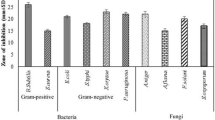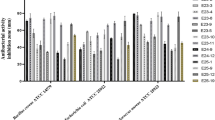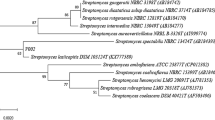Abstract
A total of 192 different Streptomyces isolates were recovered from 34 soil samples collected from different localities in Egypt. The cytotoxic activities of culture supernatant of each of the recovered isolate were investigated against Caco-2 cell line using 3-(4,5-dimethylthiazol-2-yl)-2,5-diphenyltetrazolium bromide (MTT) assay. The Streptomyces isolate coded S19, that showed the highest cytotoxic activity against Caco-2 cell line (CD50 of 26.4 µg/mL), was identified using 16S rRNA gene sequence analysis as Streptomyces variabilis isolate MW091521. The influence of cultural parameters affecting the cytotoxic activity of the respective isolate including the different culture media, initial pH value, temperature and rotation speed was investigated. A maximum cytotoxic activity (CD50 of 13.4 µg/mL) was obtained using the culture medium of soybean meal at an initial pH of 7.0, incubation temperature 28°C and 200 rpm. Thereafter, the fermentation was conducted in a 14 L laboratory fermenter under the previously stated optimum conditions with the aim of extraction, and purification of cytotoxic metabolite(s). Fractionation of the ethyl acetate extract followed by advanced spectroscopic analysis using LC/ESI/MS as well as 1D and 2D NMR experiments yielded the cytotoxic metabolite heliomycin. To the best of our knowledge, this is the first report on the production of heliomycin by Streptomyces variabilis isolate MW091521.






Similar content being viewed by others
REFERENCES
Calisto, R., Sæbø, E.F., Storesund, J.E., Øvreås, L., Herfindal, L., and Lage, O.M., Front. Mar. Sci., 2019, vol. 5, no. 499, pp. 1–10.
Mann, J., Nat. Rev. Cancer, 2002, vol. 2, no. 2, pp. 143–148.
Blunt, J.W., Copp, B.R., Hu, W.-P., Munro, M.H.G., Northcote, P.T., and Prinsep, M.R., Nat. Prod. Rep., 2009, vol. 26, no. 2, pp. 170–244.
Berdy, J., J. Antibiotechnol., 2005, vol. 58, pp. 1–26.
Kharat, K.R., Kharat, A., and Hardikar, B.P., Afr. J. Biotechnol., 2009, vol. 8, no. 23, pp. 6645–6648.
Nakae, K., Yoshimoto, Y., Sawa, T., Homma, Y., Hamada, M, Takeuchi, T., and Imoto, M., J. Antibiot., 2000, vol. 53, no. 10, pp. 1130–1136.
Felth, J., Rickardson, L., Rosén, J., Wickström, M., Fryknäs, M., Lindskog, M., et al., J. Nat. Prod., 2009, vol. 72, no. 11, pp. 1969–1974.
Ceylan, O., Okmen, G., and Ugur, A., EurAsian J. Biosci., 2008, vol. 2, no. 1, pp. 73–82.
Siddique, S., Syed, Q., Adnan, A., and Qureshi, F.A., Jundishapur J. Microbiol., 2014, vol. 7, no. 6. https://doi.org/10.5812/jjm.10366
Strober, W., Curr. Protoc. Immunol., 2001. https://doi.org/10.1002/0471142735.ima03bs21
Peng, Y., Wang, Y.H., Zhang, S.L., Chu, J., Zhuang, Y.P., Wang, M.L., and Zhou, J., J. Microbiol. Methods, 2008, vol. 73, no. 2, pp. 105–110.
Saliba, A.M., Filloux, A., Ball, G., Silva, A.S.V., Assis, M.-C., and Plotkowski, M.-C., Microb. Pathog., 2002, vol. 33, no. 4, pp. 153–166.
Murakami, J., Kishi, K., Hirai, K., Hiramatsu, K., Yamasaki, T., and Nasu, M., Int. J. Antimicrob. Agents, 2000, vol. 15, no. 2, pp. 103–109.
Eden, P.A., Schmidt, T.M., Blakemore, R.P., and Pace N.R., Int. J. Syst. Bacteriol., 1991, vol. 41, no. 2, pp. 324–325.
Kavitha, A. and Vijayalakshmi, M., JASR, 2009, vol. 5, no. 12, pp. 2138–2147.
Mahmoud, A.A., Essawy, E.A., Abdalla, M.S. and Abdelfattah, M.S., J. Biosci. Appl. Res., 2019, vol. 5, pp. 429–436.
Radwan, H.H., Moussa, I.M., and Alsarra, I.A., Afr. J. Biotechnol., 2013, vol. 10, no. 9, pp. 1690–1965.
Al-Humiany, A.U.-R., Res. J. Microbiol., 2011, vol. 6, no. 4, pp. 328–342.
Sudha, S. and Masilamani, S.M., Asian Pac. J. Trop. Biomed. 2012, vol. 2, no. 10, pp. 770–773.
Osada, N., Kohara, A., Yamaji, T., Hirayama, N., Kasai, F., Sekizuka, T., et al., DNA Res., 2014, vol. 21, no. 6, pp. 673–683.
Sato, B., Muramatsu, H., Miyauchi, M., Hori, Y., Takase, S., Motohero, H., et al., J. Antibiot., 2000, vol. 53, no. 2, pp. 123–130.
Maskey, R.P., Helmke, E., Kayser, O., Fiebig, H., Maier, A., Busche, A., and Laatsch, H., J. Antibiot., 2004, vol. 57, no. 12, pp. 771–779.
Hayakawa, Y., Shirasaki, S., Shiba, S., Kawasaki, T., Matsuo, Y., Adachi, K., and Shizuri, Y., J. Antibiot., 2007, vol. 60, no. 3, pp. 196–200.
Ahmed, A.A., Saudi J. Biol. Sci., 2007, vol. 14, no. 1, pp. 7–16.
Atta, H.M., El-Sehrawi, M.H., and Bahobail A.S., Am. J. Sci., 2011, vol. 7, no. 3, pp. 13–22.
Arora, S.K., J. Antibiot., 1985, vol. 38, no. 1, pp. 113–115.
Gorajana, A., Venkatesan, M., Vinjamuri, S., Kurada, B., Peela, S., Jangam, et al., Microbiol. Res., 2007, vol. 162, no. 4, pp. 322–327.
Abdelfattah, M.S., Elmallah, M.I.Y., Faraag, A.H.I., Hebishy, A.M.S., and Ali, N.H., 3 Biotech, 2018, vol. 8, no. 6, рр. 282–290.
Slesarchuk, N.A., Khvatov, E.V., Chistov, A.A., Proskurin, G.V., Nikitin, T.D., Lazarevich A.I., et al., Bioorganic Med. Chem. Lett., 2020, vol. 30, no. 10, art. 127100.
Chueh, P.J., Islam, A., Chen, X.Q., Chiu, S.H., Tikhomirov, A.S., and Shchekotikhin, A.E., Cancer Res., 2020, vol. 80, no. 16. https://doi.org/10.1158/1538-7445.AM2020-6224
ACKNOWLEDGMENTS
We hereby acknowledge the Postgraduate and Scientific Research Sector of Ain Shams University for supplying us the chemicals required for performing the practical work and for providing all the required facilities to perform the experiments.
Ethics approval and consent to participate. Not applicable.
Consent for publication. Not applicable.
Availability of data and materials. All data generated or analyzed during this study are included in this published article in the main manuscript.
Funding
The authors declare that no funding was received.
Author information
Authors and Affiliations
Corresponding author
Ethics declarations
The authors declare that they have no conflict of interest. This article does not contain any studies involving animals or human participants performed by any of the authors.
Rights and permissions
About this article
Cite this article
Abu Zaid, A.S., Yassien, M.A., Aboshanab, K.M. et al. Streptomyces variabilis Isolate MW091521: a New Microbial Source of Heliomycin. Appl Biochem Microbiol 57, 564–570 (2021). https://doi.org/10.1134/S0003683821050021
Received:
Revised:
Accepted:
Published:
Issue Date:
DOI: https://doi.org/10.1134/S0003683821050021




